I no more blog on blogspot. You can now find my writing here - http://bharathwrites.in
A Little Understood
Wednesday, July 24, 2013
Sunday, December 17, 2006
Winter 2006: Ellora And Ajanta
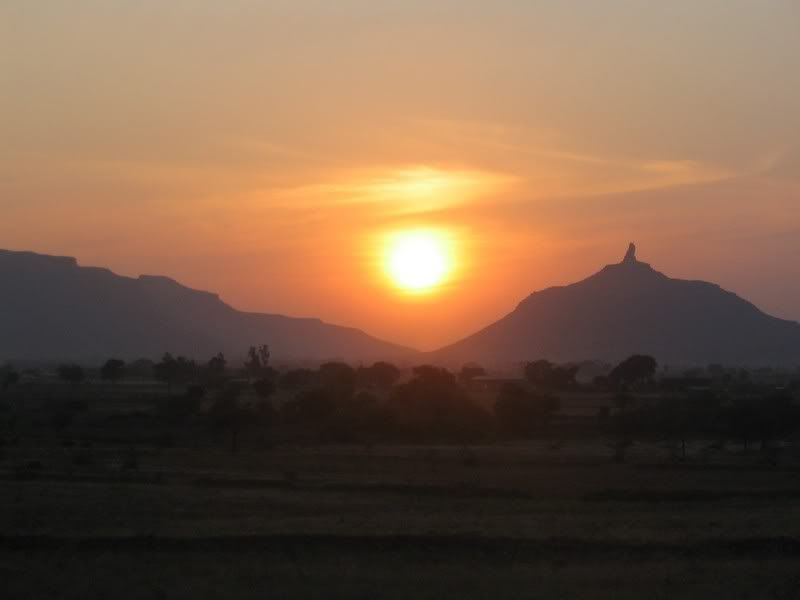 The inspiration for this one was my insistence for a getaway, having seen my parents travel more than me after many years. This trip too was planned and put in place by my dad like all other trips. I have had this urge to knock off as many sites from the list of "India's World Heritage Sites". Didnt know what to expect of these places, so started of with a satisfaction that I was going to have one site less at the end of 2006(and happy to be boarding Karnataka Express again). But as it turned out, Ellora just got added to the list of places I want to keep coming back.
The inspiration for this one was my insistence for a getaway, having seen my parents travel more than me after many years. This trip too was planned and put in place by my dad like all other trips. I have had this urge to knock off as many sites from the list of "India's World Heritage Sites". Didnt know what to expect of these places, so started of with a satisfaction that I was going to have one site less at the end of 2006(and happy to be boarding Karnataka Express again). But as it turned out, Ellora just got added to the list of places I want to keep coming back.Getting down at Manmad we reached Aurangabad at night. Aurangabad was much bigger than I expected. Being driven around in the city I couldnt stop my mind from going back to the kind of news I had been reading about this place. Very close to our guesthouse was a circle with a Sambhaji Raje bust capturing the often reproduced tale of him slaying the tiger. But as our driver pointed out, Aurangabad is overlooked by the same hills where he was tortured for 40 harrowing days.
Our site seeing began the next day. Grushneshwar, our first stop, is probably the least visited jyotir-linga. Almost a twin brother of Bhima-shanker in architecture and atmosphere. Standing right next to Ellora, we headed there next only to be told that it was closed on Tuesdays. After some fenetic phone-calls it was confirmed that Ajanta didnt close on any weekday. For a moment I thought if this was deliberately so, afterall the place had been forgotten for a thousand years.
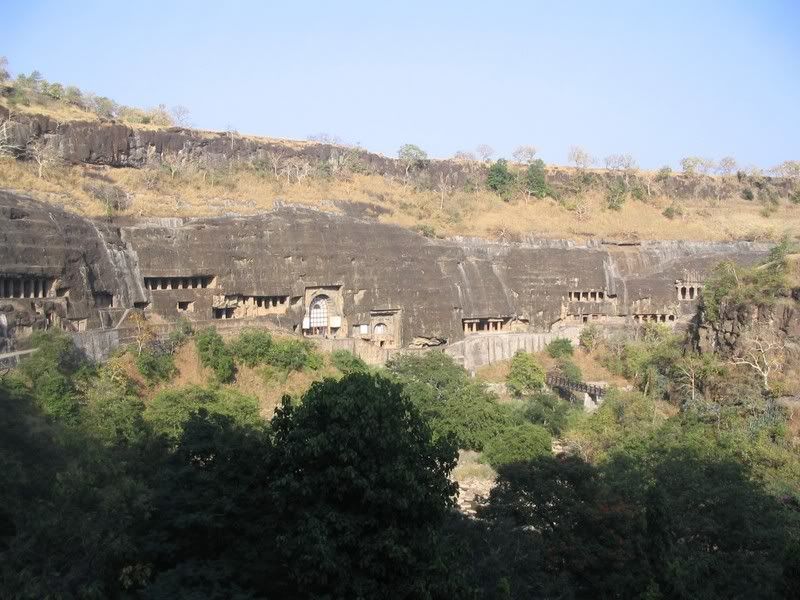
It was past 12 in midday when we reached Ajanta. Tucked away remotely, the caves are almost at the vertical-centre of the hills. Hot in november, not even half the tourists to this place were indian. We unintentionally followed a few sinic tourists who reminded me of what I had seen in their countries - the remainings of the buddhist forays into Japan, Korea, Thailand, Malaysia etc. Ajanta is completely buddhist without being monotonous. Its beyond me to fathom the devotion of the hundreds who built it. Working in these gorges for centuries they must have lived life for a higher reason. Though most of the work is attributed to monks, it is quite impossible that it was only them. There must have been other people working, with family and children. I thought of them in disbelief. Disbelief for the kind of sway buddhism held during those times. Buddhism, which was to be reasoned out by Adi Shankara and slaughtered out by Islam.
Headed to Ellora the next day. Ellora with its equal share of Buddhist, Hindu and Jain caves has lost all its cave paintings. Just when the Bodhisattavas, Vajrapani's and Padmapani's were getting a little excessive came the Hindu pantheon in full glory. Ravana lifting Kailas (bhu-kailas), Mahishasura Mardhini, Varahavatara, Narasimhavatara form the massive, frequent depictions.

But the zenith of the genius of these builders is the Kailasnath Temple. The world's biggest rock monolith. The very sight of this massive temple had a stupefying effect on me. The rock or should I say the hill itself parts way to become the temple of the lord. The massive unsupported roof, the biggest of its kind in the world, lends shelter to the pradakshina-patha. The glory of the planning and design can be visaualized when one finds that the shiva-linga in the main garbha-griha is not a separate sculpture brought in but the part of the same hill which has been cut top-down.
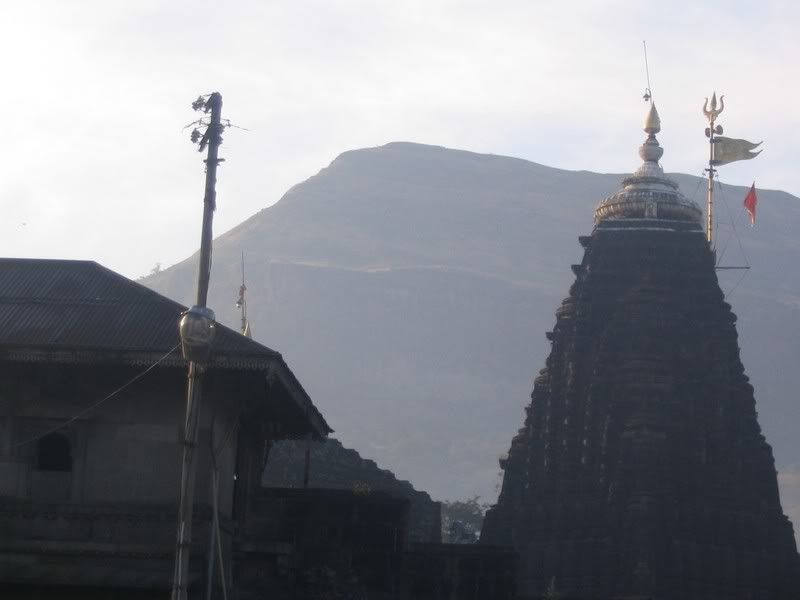 Next day, 24th Nov, was my father's birthday. We travelled to Traimbakeshwar, another jyotir ling, and the birthplace of Godavari. A typical Hindu religious township, the food and lodging was most satisfying here. The temple in the backdrop of the Brahmagiri is serene. We trekked up the hill which by itself is considered as Lord Shiva, to a place where a stream bustles. Along the way down, mom asked a few Marathi ladies to sing something for us. Sitting atop the Vindhyas, listening to the folklore, I tried to imagine Shiva unleashing Ganga here. Looking at the crowd of devotees visible even from the hill top, I guess even I would have chosen this place for the river if I had the chance.
Next day, 24th Nov, was my father's birthday. We travelled to Traimbakeshwar, another jyotir ling, and the birthplace of Godavari. A typical Hindu religious township, the food and lodging was most satisfying here. The temple in the backdrop of the Brahmagiri is serene. We trekked up the hill which by itself is considered as Lord Shiva, to a place where a stream bustles. Along the way down, mom asked a few Marathi ladies to sing something for us. Sitting atop the Vindhyas, listening to the folklore, I tried to imagine Shiva unleashing Ganga here. Looking at the crowd of devotees visible even from the hill top, I guess even I would have chosen this place for the river if I had the chance.
Saturday, November 11, 2006
Winter 2005: In Krishna's Kingdom
Hot winds blew into my face in December as I sat listening to the story-telling by our enthusiastic driver, Munnabhai. Lord Krishna, he said, grew afraid due to repeated wars by Jarasandha on Mathura, after Krishna killed Kamsa. Munnabhai had no doubt that Krishna was scared, though a few minutes earlier, he had disagreed with the concept of non-duality of God and man (advaita). So according to him, Krishna, the born God was scared, though omnipotent. We were heading to Dwaraka in Gujarat, where the historic king meets the divine lord, and maybe such contrdictions become unavoidable.
We had taken the spicejet "no-frills" flight to Ahmedabad. The next day arriving at the Akshardham temple complex it dawned to me that the "no-frills" travel was truly over. Akshardham with all its opulence, is built by the followers of the Swaminarayan pantha. There is no Puja, Garbha-griha etc the hallmarks of hindu temples. Fortified due to the terrorist attack, I could not manage a single photograph. The massive complex entertains massive populace. And the temple celebrates the Swaminarayan cult as seperate religion, away from Hinduism. Though the hindu gods are all present, the cult seems to be in this inebriated state due to the wealth amassed by its followers abroad. Had the terrorists known this, I guess they would have targeted the CM's residence instead (a stone throw away from the temple) and allowed such divisions to perpetuate.
Sometimes in travels, its the unexpected destinations that remain etched in ones mind. One such place for me from this trip was the Adalaj vav. The Sabarmati ashram is serene and a must see for its collection of photographs.
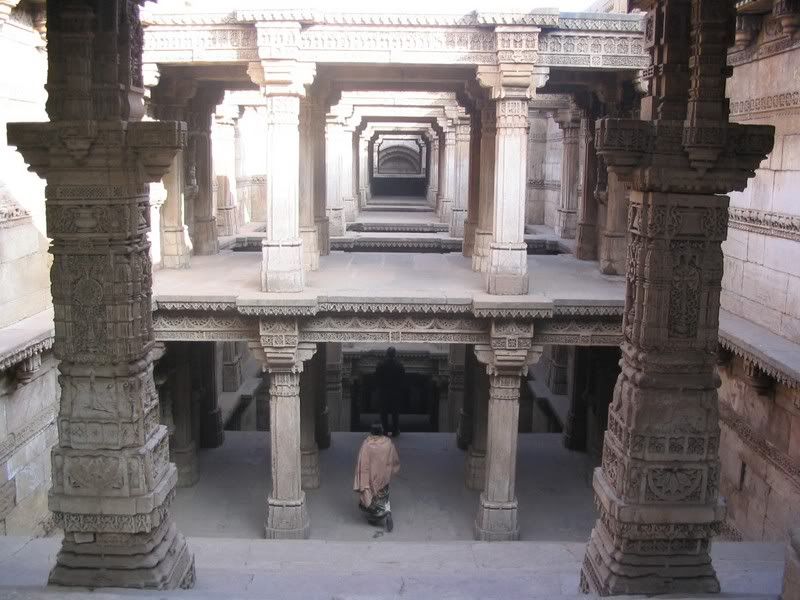
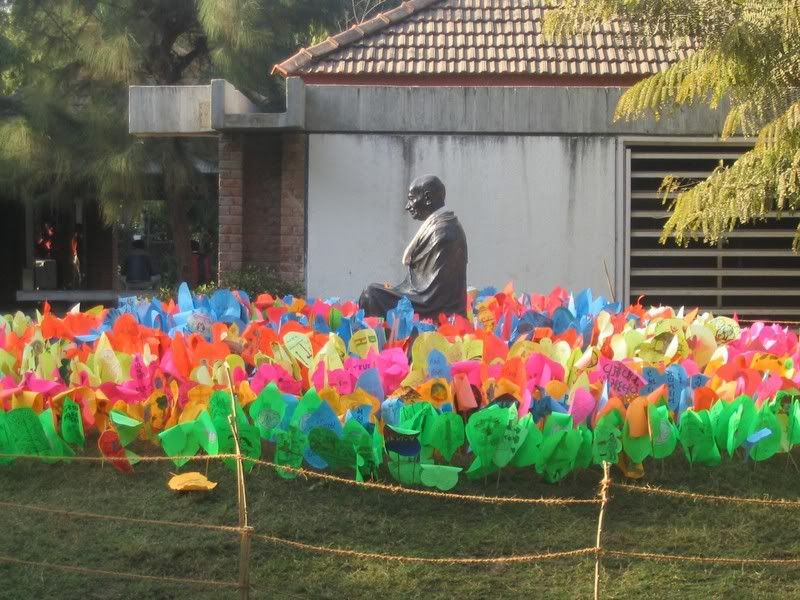
After the Ahmedabad sight-seeing, we headed to Lothal early next morning. To my surprise we ran into the CPM's inutile AB.Bardhan in the small museum. He seemed to be getting tutored on the lack of resemblance of today's deity's with those found on the old mud bricks kept there. I reflected within if I would see the day when the commie's AIT would be as extinct as lothal's rhinos. But as a place, lothal is all for ones imagination. We rushed to Palitana next. Starting the climb up at close to 3PM I was apprehensive if my mom could complete the climb up and back (4000X2 steps) before dusk. As always she beat my expectations. With more than 1000 Jain temples, all carved out of marble, this Adinath shrine lives up to the expectations of the hundreds of perspiring young men climbing barefoott after days of fasting.
Next day we headed to Gir, the sole natural habitat of the Asiatic lion. Entering the safari late evening in the open jeep, the joke which went round was that we were probably the first decendents in our family with Lord Narasimha as the family-patron-god, to actully see lion in the wild. For more than an hour all we saw was deer and neel-gai. The initial excitement due to close proximity of these fellows also died down. What we were looking for was so camouflaging that in an hour my mom had spotted a dozen lions and panthers, with our guide shaking his head vigorously in disbelief. But finally we spotted one. My binoculars helped. I guess we were the only ones, in almost a dozen jeeps to really see the king of the forest. It was far and was with its mate. But it was not until the next day when we saw few lions in captivity that we were satisfied.
The evening of 26th Dec, we reached Somanatha. Somanatha caught my imagination when Sri Advani embarked on the historic Rath-yatra. I heard of its history from my mother. And I read about it later in the words of KM Munshi. Till Hinduism stands, Somanatha will.
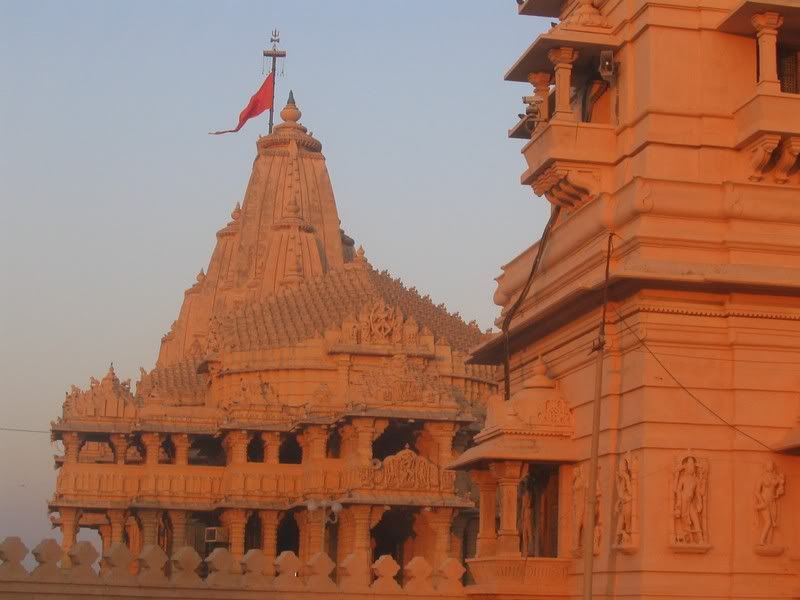
The chorus bhajan at the dawn and dusk are easily the most magnificent pujas that I have seen in any temple in my life. The atmosphere can melt a stone. The view of the new temple from the beach is fantastic. The facilites by the temple trust are as good as can be. The temple built by Ahilaya Bai Holkar with the linga hidden in the basement to preseve from the invading muslims is right opposite to the destroyed old temple. The late evening sound-n-light show, beamed on the temple itself and in the booming voice of Amrish Puri, left the packed crowd emotional. The next morning we visited the museum which preserves the remains of the destroyed temple.
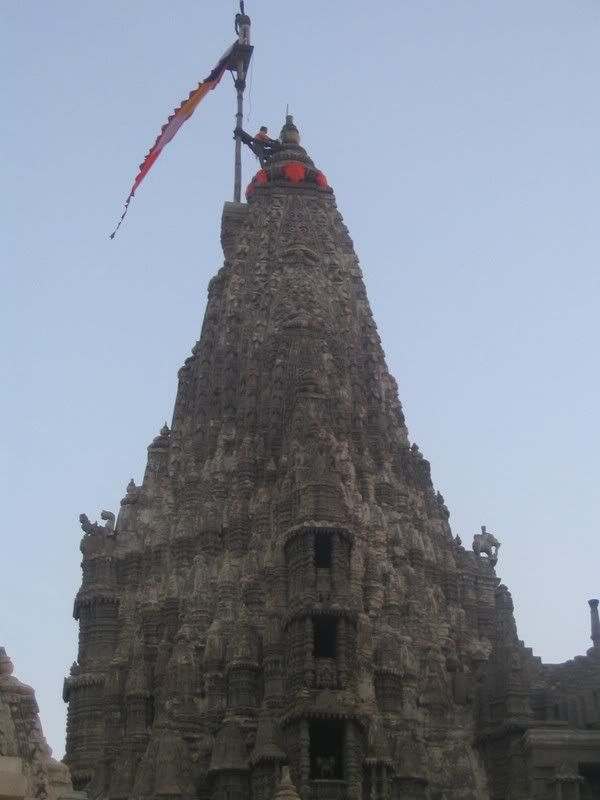 After a brief jaunt at Nageshwar, a jyotir ling, we headed to Dwaraka. The real Dwaraka of Sri Krishna, bet-dwaraka, is today under sea. Discovered by the research of the great Sri SR Rao. For some reason I found Dwaraka to have the same aura as the other hindu religious sites in UP. After a visit to the temple and having participated in the wonderful evening bhajan, we witnessed the Dhwaj changing atop the gopuram. A man climbed up to the tip of the gopuram balancing on a 15 feet bamboo stick hoisting a 50 feet flag. A new flag for each day donated by competition. The Dwaraka Shankaracharaya peetha is present inside the temple complex.
After a brief jaunt at Nageshwar, a jyotir ling, we headed to Dwaraka. The real Dwaraka of Sri Krishna, bet-dwaraka, is today under sea. Discovered by the research of the great Sri SR Rao. For some reason I found Dwaraka to have the same aura as the other hindu religious sites in UP. After a visit to the temple and having participated in the wonderful evening bhajan, we witnessed the Dhwaj changing atop the gopuram. A man climbed up to the tip of the gopuram balancing on a 15 feet bamboo stick hoisting a 50 feet flag. A new flag for each day donated by competition. The Dwaraka Shankaracharaya peetha is present inside the temple complex.
This trip was confined to the Kathiawar region of Gujarat. One the most prosperous country sides. I bide my time to come back to this region again...
We had taken the spicejet "no-frills" flight to Ahmedabad. The next day arriving at the Akshardham temple complex it dawned to me that the "no-frills" travel was truly over. Akshardham with all its opulence, is built by the followers of the Swaminarayan pantha. There is no Puja, Garbha-griha etc the hallmarks of hindu temples. Fortified due to the terrorist attack, I could not manage a single photograph. The massive complex entertains massive populace. And the temple celebrates the Swaminarayan cult as seperate religion, away from Hinduism. Though the hindu gods are all present, the cult seems to be in this inebriated state due to the wealth amassed by its followers abroad. Had the terrorists known this, I guess they would have targeted the CM's residence instead (a stone throw away from the temple) and allowed such divisions to perpetuate.
Sometimes in travels, its the unexpected destinations that remain etched in ones mind. One such place for me from this trip was the Adalaj vav. The Sabarmati ashram is serene and a must see for its collection of photographs.


After the Ahmedabad sight-seeing, we headed to Lothal early next morning. To my surprise we ran into the CPM's inutile AB.Bardhan in the small museum. He seemed to be getting tutored on the lack of resemblance of today's deity's with those found on the old mud bricks kept there. I reflected within if I would see the day when the commie's AIT would be as extinct as lothal's rhinos. But as a place, lothal is all for ones imagination. We rushed to Palitana next. Starting the climb up at close to 3PM I was apprehensive if my mom could complete the climb up and back (4000X2 steps) before dusk. As always she beat my expectations. With more than 1000 Jain temples, all carved out of marble, this Adinath shrine lives up to the expectations of the hundreds of perspiring young men climbing barefoott after days of fasting.
Next day we headed to Gir, the sole natural habitat of the Asiatic lion. Entering the safari late evening in the open jeep, the joke which went round was that we were probably the first decendents in our family with Lord Narasimha as the family-patron-god, to actully see lion in the wild. For more than an hour all we saw was deer and neel-gai. The initial excitement due to close proximity of these fellows also died down. What we were looking for was so camouflaging that in an hour my mom had spotted a dozen lions and panthers, with our guide shaking his head vigorously in disbelief. But finally we spotted one. My binoculars helped. I guess we were the only ones, in almost a dozen jeeps to really see the king of the forest. It was far and was with its mate. But it was not until the next day when we saw few lions in captivity that we were satisfied.
The evening of 26th Dec, we reached Somanatha. Somanatha caught my imagination when Sri Advani embarked on the historic Rath-yatra. I heard of its history from my mother. And I read about it later in the words of KM Munshi. Till Hinduism stands, Somanatha will.

The chorus bhajan at the dawn and dusk are easily the most magnificent pujas that I have seen in any temple in my life. The atmosphere can melt a stone. The view of the new temple from the beach is fantastic. The facilites by the temple trust are as good as can be. The temple built by Ahilaya Bai Holkar with the linga hidden in the basement to preseve from the invading muslims is right opposite to the destroyed old temple. The late evening sound-n-light show, beamed on the temple itself and in the booming voice of Amrish Puri, left the packed crowd emotional. The next morning we visited the museum which preserves the remains of the destroyed temple.
 After a brief jaunt at Nageshwar, a jyotir ling, we headed to Dwaraka. The real Dwaraka of Sri Krishna, bet-dwaraka, is today under sea. Discovered by the research of the great Sri SR Rao. For some reason I found Dwaraka to have the same aura as the other hindu religious sites in UP. After a visit to the temple and having participated in the wonderful evening bhajan, we witnessed the Dhwaj changing atop the gopuram. A man climbed up to the tip of the gopuram balancing on a 15 feet bamboo stick hoisting a 50 feet flag. A new flag for each day donated by competition. The Dwaraka Shankaracharaya peetha is present inside the temple complex.
After a brief jaunt at Nageshwar, a jyotir ling, we headed to Dwaraka. The real Dwaraka of Sri Krishna, bet-dwaraka, is today under sea. Discovered by the research of the great Sri SR Rao. For some reason I found Dwaraka to have the same aura as the other hindu religious sites in UP. After a visit to the temple and having participated in the wonderful evening bhajan, we witnessed the Dhwaj changing atop the gopuram. A man climbed up to the tip of the gopuram balancing on a 15 feet bamboo stick hoisting a 50 feet flag. A new flag for each day donated by competition. The Dwaraka Shankaracharaya peetha is present inside the temple complex.This trip was confined to the Kathiawar region of Gujarat. One the most prosperous country sides. I bide my time to come back to this region again...
Saturday, August 05, 2006
Summer 2005: Jai Shivaji
 I had heard the stories of Chatrapati Shivaji Maharaj from my mother as a kid. Shivaji, who took on the powerful Mughals and carved a "Hindavi Swaraj". Shivaji, who never lost on Battle-field. But then, history is filled with great warriors who never lost on battle-field...Achilles, Alexander, Changez Khan, Napoleon, William Wallace, Sun Tzu and so on...But how many times do we come across a Warrior who never lost the love of his people during and after his time?
I had heard the stories of Chatrapati Shivaji Maharaj from my mother as a kid. Shivaji, who took on the powerful Mughals and carved a "Hindavi Swaraj". Shivaji, who never lost on Battle-field. But then, history is filled with great warriors who never lost on battle-field...Achilles, Alexander, Changez Khan, Napoleon, William Wallace, Sun Tzu and so on...But how many times do we come across a Warrior who never lost the love of his people during and after his time?I had dreamt of his battles, his forts. I wanted to see the "gad" for which Maharaj fought for. Wanted to see the places hallowed by Maharaj.
We traveled to Pune, the capital of Peshwas, from Bangalore by train. Pune, from where the last Maratha, Baji Rao, ruled. The once magnificent 7 storeyed palace of teak and lime in Shaniwar-Wada does not exist anymore. Only the rock fort and its ramparts do. The fort was burnt down by a fire, by British. This incident was to inspire future heroes like Vasudev Balawant Phadke.
We next traveled to "Simha-Gad" fort which is at a short distance from Pune. I had read of "Simha-Gad" from a chapter in school titled "gad Aaya par Simha Gaya" much before I read books like "Yugavatar"
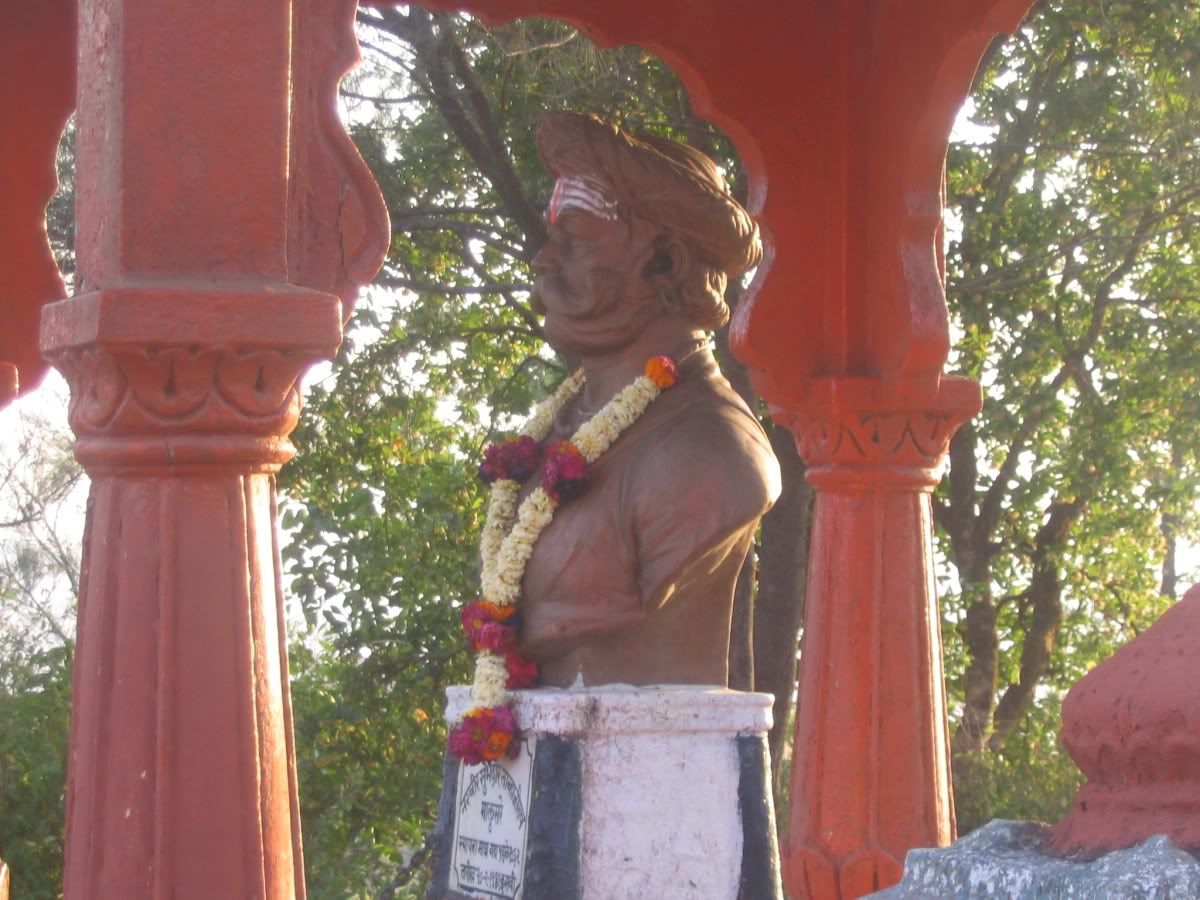 Shivaji is ordered to win the fort by Jija Mata. Shivaji entrusts winning the Gad from Uday Bhan, the mughal ruler, to Tanaji Malusure. Tanaji puts aside his sons wedding to win the fort. He climbs it using Iguanas and is mortally wounded in the battle with Uday Bhan. The marathas however go on to win the fort and the "Bhagawa" is unfurled in the morning to the pleasure of Jija Mata. (adjacent pic is the bust of Tanaji Malusure atop Simhagad)
Shivaji is ordered to win the fort by Jija Mata. Shivaji entrusts winning the Gad from Uday Bhan, the mughal ruler, to Tanaji Malusure. Tanaji puts aside his sons wedding to win the fort. He climbs it using Iguanas and is mortally wounded in the battle with Uday Bhan. The marathas however go on to win the fort and the "Bhagawa" is unfurled in the morning to the pleasure of Jija Mata. (adjacent pic is the bust of Tanaji Malusure atop Simhagad)The next day, we traveled to two places - Bhima-shanker & Shivaneri - and came back to Pune.
Bhima-Shanker is one of the "jyotir-lingas". It is here that Lord Shiva is said to have slain Tripurasura. Not far from this place is "Shivneri". The birth-place of kalyuga's Shiva, the mightiest warrior of Santana Dharma.
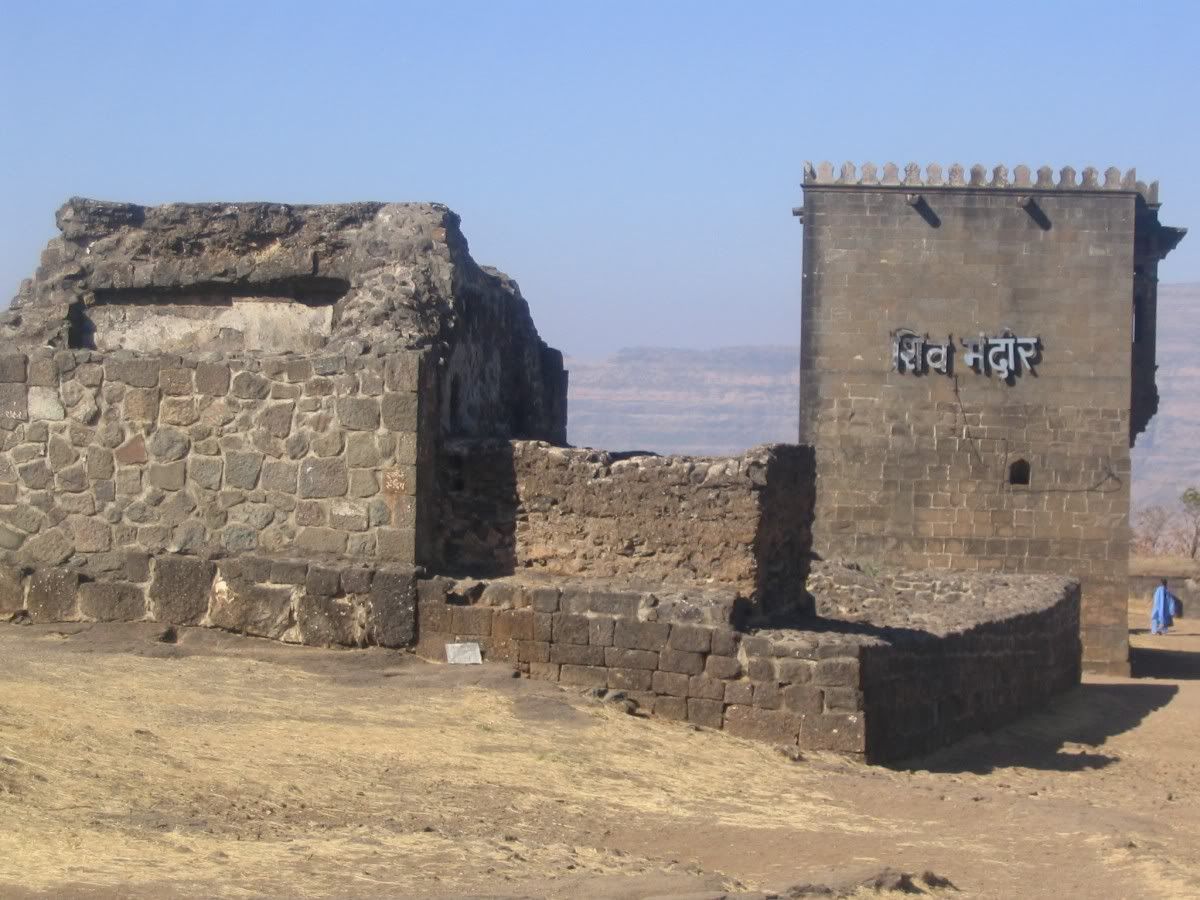
Shivneri is a tough fort to trek for elders. Only me and my sister made it to the top. The fort is in ruins and that is distressing.
As we climbed up, as it often happens in Indian travels, we met up with a big herd of school kids. They were in high spirits and it seemed more so because they were away from school.
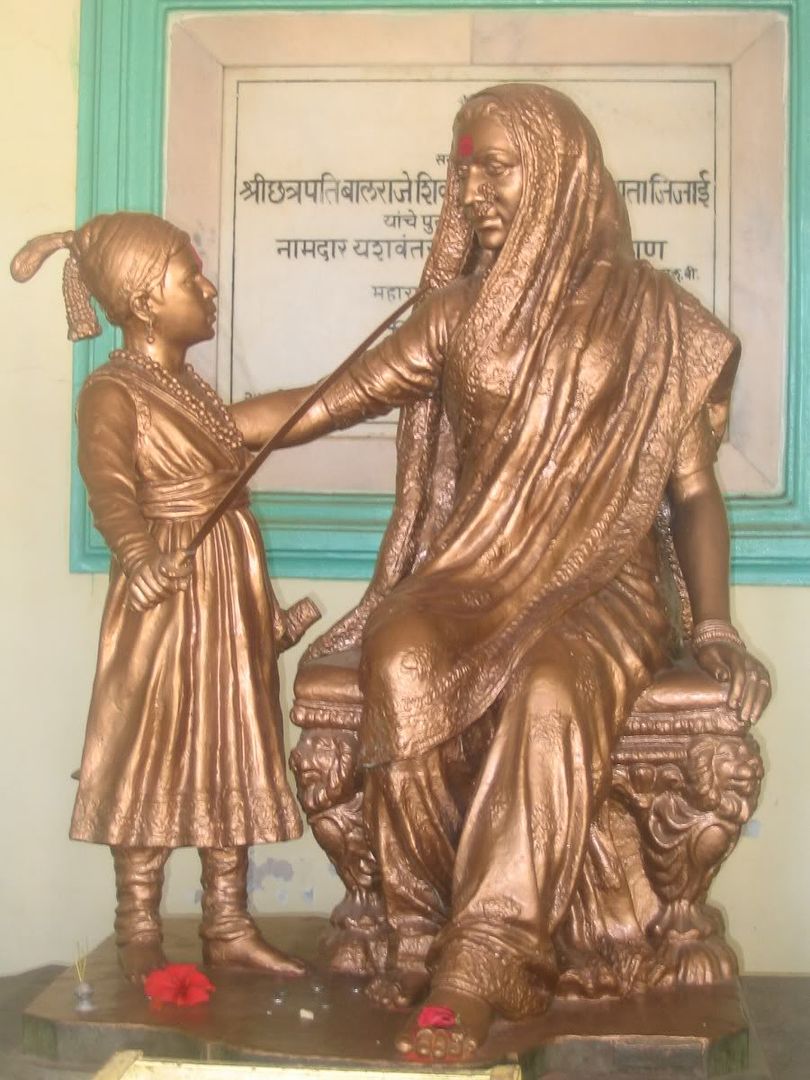 There is a newly built Memorial at the hill top. At a slight distance away from it are the remains of the old fort where Shiv-ba was born(top-pic). The memorial has a beautiful bronze statue of boy Shiv-ba being moulded by his mother.
There is a newly built Memorial at the hill top. At a slight distance away from it are the remains of the old fort where Shiv-ba was born(top-pic). The memorial has a beautiful bronze statue of boy Shiv-ba being moulded by his mother.The next day we traveled to Mahabaleshwar. Mahabaleshwar is a popular hill station in the Sahyadris with many boarding schools and Strawberry farms. The back-waters of the Koyna dam are close by. We went boating there and I was surprised to see populated island-villages in the waters.
Close by is the Pratapgad fort. This fort stands witness to one the most spectacular encounters of Maharaj - Afzal Khan, a Bijapuri general, is deputed to defeat Shivaji. Khan is a beasty man of close to 6'1/2 feet while Maharaj is nearly a feet shorter. Khan surrounds pratapgad and waits but the siege does not yield. He decides to kill Shivaji by deceit and asks for a personal meeting at the foot of pratapgad. Maharaj arrives with a trusted lieutenant and so does Khan. Khan tries to embrace Shivaji at the first sight and while doing so pulls his dagger out and stabs Shivaji in his side. But fortunately, the dagger hits Shivaji's steel vest. At this, Maharaj, who used to were "Vyaghra-nakha" (claws of lion, so called due to resemblence but actually steel) jabs it into the stomach of Khan and tears his bowels open. Khan and his lieutenant are killed and the Bijapur army flees.
This incident has always fascinated me due to its resemblence with the story of "Narasimha-avatar" of the Hindu pantheon.
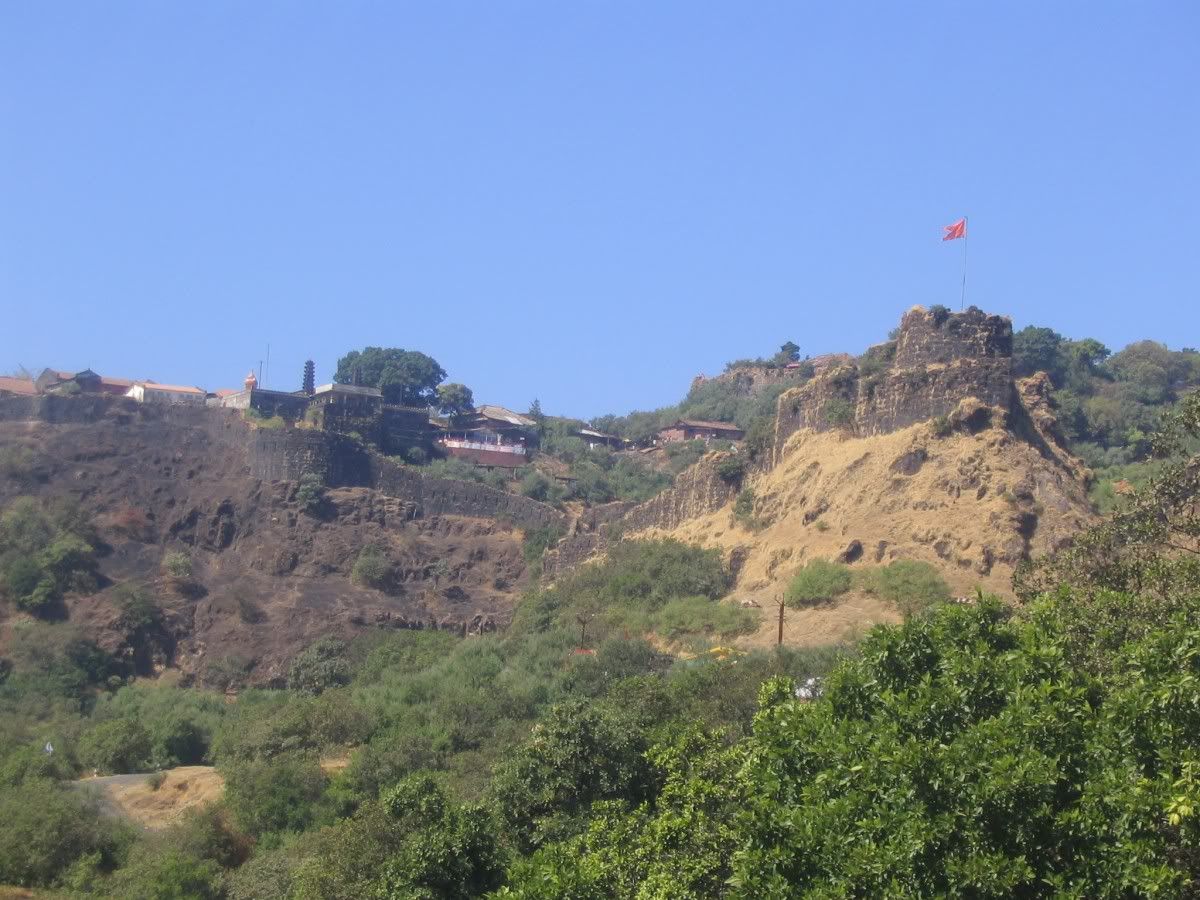
We stayed that night in Mahabaleshwar and went on to "Rai-Gad" - the capital of Shivaji - the next day morning. Raigad was chosen by Shivaji due to two easily identifiable reasons - (1) Its an almost vertical peak, which makes climbing by a invading army impossible (2) The top of the hill itself is quite vast and habitable by a significant populace. The tourists are obviated the treacherous climb by a ropeway. But the ropeway itself is not a very encouraging sight, with only 2 pillars (one at the peak and one down-hill) supporting the whole steel-rope. But then, the company manages it well. They also have a small museum of Maharaj with various articles and portraits of his times.
We reached Raigad in the evening and decided to go up immediately. As with all the other forts, this fort too is in ruins.
 Whatever might be the historical reasons for these forts falling to disuse, the current "proud" Maharashtrian people and Govt should be ashamed of the present state.
Whatever might be the historical reasons for these forts falling to disuse, the current "proud" Maharashtrian people and Govt should be ashamed of the present state.Shivaji was coronated in Raigad. People bestowed the title of "Chatrapati" on him. A "pancha-loha" statue of Chatrapati Shivaji Maharaj resides at the site (first-pic). The people of a nearby village trek everyday to Raigad to garland the statue. Such is the adoration of Shivaji Maharaj by the people
Raigad has elaborate palace and public quarters. The main entrance of the fort has the symbol of Lion taming 3 elephants. Lion symbolizes the Marathas and the elephants - Qutubshahi, Adilshahai and Mughal. There is a small lake inside the ramparts to which the sacred water from the various rivers of Bharat were brought for Shivaji's coronation.
Shivaji had brought a baby-elephant during his youth to Raigad and tamed it. Its impossible for a grown elephant to climb the hill. He rode this very elephant after many years (when it had grown up) during his coronation ceremony.
 Our local guide proudly told this to us, venerating the farsightedness of his hero.
Our local guide proudly told this to us, venerating the farsightedness of his hero.Downhill, we next went to samadhi of Jija Mata. "Rashtra Sevika Samiti" the women's wing of RSS has renovated and continues to maintain it.
On our way back we went to Goa, to its popular beaches.
To me, this trip in December 2004 is still very fresh. I hope more people go to these places. Also as I see the movies of Achilles and Alexander, I wonder, when our modern cinema would take a break from its infinite love stories and decide to cast real heroes.
Monday, July 31, 2006
Bangalore bomber went to Iran
There were protests in Bangalore during Iraq war time where the commies shouted that its USA and not Iran thats at the centre of "axis of evil". We again saw huge protests by commie+muslim alliances in Lucknow, Delhi etc when India voted against Iran in the UN. Most Indians remain unaware of the threat that Iran poses directly to Indian Security.
B.Raman quotes Hindu that Muzzamil, the techie from Bangalore who helped blow the Mumbai Trains had reached Pak through Iran.
The Iranian Ayotollah's and Pakistan's Wahabis are the most bloody of Islamic schools that justify Jihad against all infidels. LeT's founder Mahmood Azhar is a wahabi. And not even a rat would enter Iran without the Ayotollah's getting to know. This one thus is a example of a direct collusion between these two for the common purpose.
It also goes on to prove why G.Bush's "axis of evil" is very much the "axis of evil" for Indians.
B.Raman quotes Hindu that Muzzamil, the techie from Bangalore who helped blow the Mumbai Trains had reached Pak through Iran.
The Iranian Ayotollah's and Pakistan's Wahabis are the most bloody of Islamic schools that justify Jihad against all infidels. LeT's founder Mahmood Azhar is a wahabi. And not even a rat would enter Iran without the Ayotollah's getting to know. This one thus is a example of a direct collusion between these two for the common purpose.
It also goes on to prove why G.Bush's "axis of evil" is very much the "axis of evil" for Indians.
Sunday, July 30, 2006
A software programmer from Bangalore bombed Mumbai Trains
Muzzamil sheikh worked for Oracle. Oracle has since denied this. But I was told by a friend of mine that he was his team-mate there, with whom he played billiards.
Anyone who saw Narayanan, the NSA, interviewed by Karan Thapar would have noted his statement - LeT has changed tactics and is more interested in recruting tech-savvy guys for terrorism
Anyone who saw Narayanan, the NSA, interviewed by Karan Thapar would have noted his statement - LeT has changed tactics and is more interested in recruting tech-savvy guys for terrorism
Friday, July 14, 2006
Dhrupad
I had to go to a concert last week. I picked up a couple of classical music CDs to get myself ready. Bought them more so as can't tolerate FM anymore in my car. Names of Pt Jasraj and Pt Rajan/Sajan Mishra on the cover helpde. I was pleasently surprised to see that they had few recitals by Gundecha brothers, whose concert I was to go. Once heard, I simply cant have enough of their listening. I must admit, they have the same trancendental quality as the illustrous other two mentinoed. To quote the host of the concert, to hear them is to witness a Tandava by the Lord himself.
And there was the divine voice of Shruti Shadolikar. I have been a listener of classical music since I can remember. But after Pt Jasraj and Pt Bhimsen Joshi, if there ever was a solo renedition that made me bow my head, it was "Har Har Deva" by this lady.
And there was the divine voice of Shruti Shadolikar. I have been a listener of classical music since I can remember. But after Pt Jasraj and Pt Bhimsen Joshi, if there ever was a solo renedition that made me bow my head, it was "Har Har Deva" by this lady.
Subscribe to:
Posts (Atom)